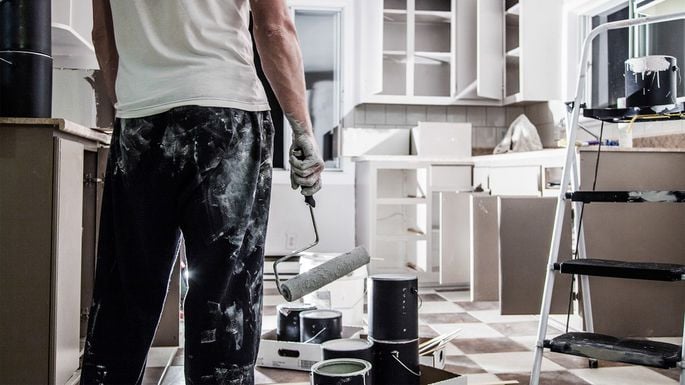8 Things That Are Bound to Go Wrong When You’re Painting a Room

Painting is one of the cheapest and easiest home makeovers out there—no knocking down walls, no pricy appliances. Just you and a brush stand between you and a whole new look!
And yet: While painting may seem easy compared to a full kitchen overhaul or erecting a new half-bath, it’s not that easy. This may explain why many people attempt the DIY route with painting, but then quickly start grumbling that there’s a whole lot more to it than what they show on HGTV.
Think you’re ready to wield a brush and roller? First, consider these eight things that are bound to go wrong when you paint a room.
1. The pain of prepping a room
Before you begin painting, you have to do some important prep work—a lotof it, in fact. These steps include covering any remaining furniture and the floors with plastic tarps or sheets you don’t mind ruining, running painter’s tape along the edge where the wall meets the ceiling, and cleaning dirt off the walls with TSP (trisodium phosphate) or another residue-free cleaner.
Ryan Benson, a professional painter in Apple Valley, MN, says prep time comprises at least 30% of a quality paint job. Don’t skimp on this part.
2. Running out of paint
Many people underestimate the amount of paint they’re going to need for a room, to the point where they have to make several schleps to Home Depot to restock. A good rule of thumb: A 1-gallon can of paint will cover up to 400 square feet, which is enough to paint a small room. Also, always assume the job will require two coats of paint (primer counts as one), since a single coat won’t give the full sheen you’re looking for.
The best way to ensure you buy enough paint is to measure the dimensions of your room and punch them into an online paint calculator, like Benjamin Moore’s.
3. The hassle of replacing paintbrushes
Unless you can paint a room in one sitting, you’ll have to temporarily store the paintbrush. The trouble is no matter how careful you are when cleaning a paintbrush, paint inevitably dries between the bristles. One solution: Purchase the Paint Brush Cover, a plastic protector that keeps the brush wet and ready to use in between coats.
4. Wavering between a dozen shades of the same color
Picking the right paint color can be a painstaking task. Indeed, there are hundreds—if not thousands—of paint colors to choose from. And while swatches enable you to test different shades, selecting what you want can still be time-consuming. Some folks even have trouble deciding on what shade of white they want. “Some whites are cool, others warm, still more are neutral, so the one you pick will depend on the room’s finishes and undertones,” says Karen Gray-Plaisted, a home staging expert with Design Solutions KGP.
5. Underestimating the costs
Between paint, primer, and supplies (e.g., brushes, rollers, sandpaper, and tape), it costs, on average, $200 to $300 to paint a 10-by-12-foot room. But those amounts can increase significantly when painting a textured wall, since texture adds more surface area, which means you need more paint to cover the entire room.
6. Underestimating the time you need
In addition to costs, you have to consider the investment of time required for painting a room yourself. If this is your first go-around, it could take you a full weekend to paint an average bedroom (12 by 12 feet). You should also consider the additional time it takes for a first coat of paint to dry before a second coat can be applied; this can be anywhere from one to 48 hours depending on the type of paint. (Check the paint can label to see what the manufacturer-recommended wait time is between coats.)
7. Coping with fumes
The unmistakable scent of a newly painted room can linger for days. The good news? There’s an easy fix.
Before painting, peel a large onion and slice it in half. Place each half on a dish and position both of them at opposite ends of the room. After the onions absorb the paint fumes, wrap and toss. And don’t worry; the smell of the onion won’t linger for more than an hour, tops.
8. Regretting a color choice once the whole room is painted
Although testing swatches can certainly help you evaluate different paint colors, it won’t guarantee that you’re going to love the color that you choose. Consequently, a number of people experience what we call “painter’s regret”—that sinking feeling you get when you finish painting a room, only to discover that you actually can’t stand the color you picked.
This is why you should always, always get a small can of the color you want and paint a 2-by-2-foot area first. See how it looks before you paint the rest, to save yourself a whole ton of time, money, and heartache starting over.

